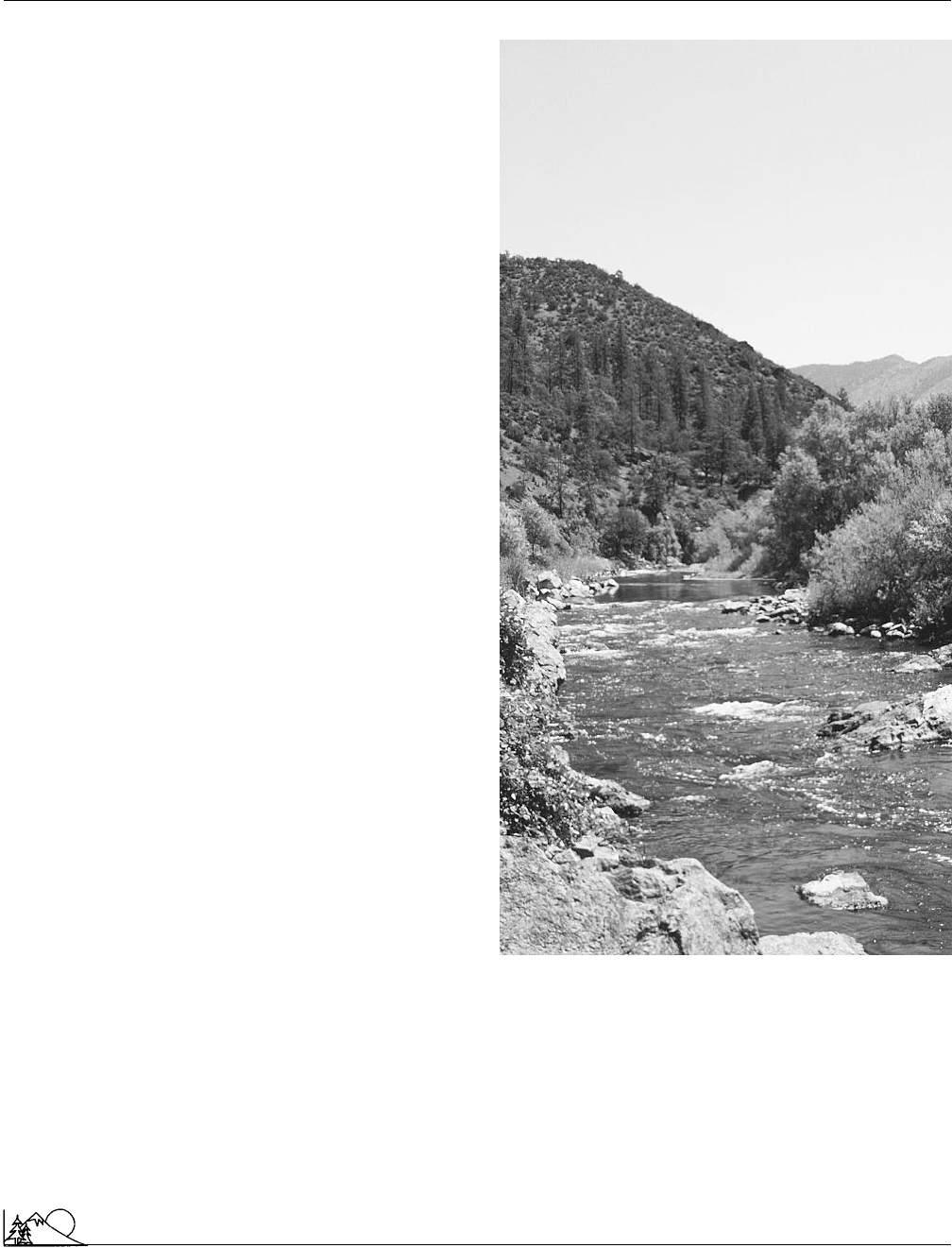Environmental Encyclopedia
Подождите немного. Документ загружается.


Environmental Encyclopedia 3
Whooping crane
After a brief illness, White died alone in his family
home at the age of 72.
[Kimberley A. McGrath]
R
ESOURCES
B
OOKS
Jenkins, A. C. The Naturalists: Pioneers of Natural History. New York:
Mayflower Books, 1978.
Lockley, R. M. Gilbert White. London: H. F. and G. Witherby, 1954.
White House Office on Environmental
Policy
see
Council on Environmental Quality
Lynn Townsend White Jr. (1907 – 1987)
American historian and writer
For most readers interested in environmental issues, White
is known by only one article: “The Historical Roots of Our
Ecological Crisis,” first published in Science in 1967, and
widely reprinted. That article, like most of White’s work,
grew out of his professional interest in medieval technology,
including technology’s role in “dominating nature.” Born in
San Francisco, schooled at Stanford and the Union Theolog-
ical Seminary, White received a doctorate in history from
Harvard University in 1934. He taught at Princeton and
Stanford Universities, spent 15 years as the President of
Mills College (1943–1958), and retired from his position of
university professor of history at the University of California
in Los Angeles in 1974.
White received most of the honors his profession could
bestow. He was a founding member of the Society for the
History of Technology, served as its president, and was also
elected president of the History of Science Society, president
of the American Historical Association, and a Fellow of the
American Academy of Arts and Sciences. Perhaps the best
introduction to his work can be obtained from two collec-
tions of articles, Machina ex Deo: Essays in the Dynamism of
Western Culture (1968) and Medieval Religion and Technol-
ogy: Collected Essays (1978).
White’s article on the ecological crisis traced that crisis
back to “modern science [as] an extrapolation of natural
theology.” The modern technology that emerged from that
science “is at least partly to be explained as an Occidental
voluntarist realization of the Christian dogma of man’s tran-
scendence of, and rightful mastery over, nature.” White then
concluded that, since modern science and technology have
led us into an ecological crisis, “Christianity bears a huge
burden of guilt.” Numerous articles over many years either
1507
picked up on White’s argument or took issue with it, a
debate White extended by “Continuing the Conversation”
in 1973, and a debate that continues today.
Although White’s article received widespread atten-
tion, his more significant contributions may have been
achieved through his extensive research on technology and
its relationship to culture and society. Of particular impor-
tance has been his establishment of connections between
religion and the way a culture perceives technology. Such
perceptions have profound implications for human relation-
ships to the
environment
. White also embraced the cause
of women’s rights, using his presidency at Mills College as a
pulpit to advance those rights, especially in higher education.
Feminist issues, such as reproduction or status, also have
profound implications for human-environment relation-
ships, and his writings in this area are still worth reading
today.
[Gerald L. Young Ph.D.]
R
ESOURCES
P
ERIODICALS
Eckberg, D. L., and T. J. Blocker. “Varieties of Religious Involvement and
Environmental Concerns: Testing the Lynn White Thesis.” Journal for the
Scientific Study of Religion 28 (December 1989): 509–517.
Hall, B. S. “Lynn Townsend White, Jr. (1907–1987).” Technology and
Culture 30 (January 1989): 194–213.
Shaiko, R. G. “Religion, Politics, and Environmental Concern: A Powerful
Mix of Passions.” Social Science Quarterly 68 (June 1987): 244–262.
White Jr., L. T. “The Historical Roots of Our Ecological Crisis.” Science
155 (March 10, 1967): 1203–7.
Whooping crane
The whooping crane (Grus americana) has long been consid-
ered the symbol for
wildlife conservation
in the United
States. This large, white, wading bird of the family Gruidae
is our tallest North American bird, standing nearly 5 ft (1.5
m) tall and having a wingspan of 7.6 ft (2.3 m). Whooping
cranes have been threatened with
extinction
since the twen-
tieth century.
Overhunting
in the latter part of the nine-
teenth and early twentieth centuries, as well as
habitat
loss—
primarily due to the conversion of
prairie wetlands
into
agricultural land—have been major contributors to this de-
cline. In modern times, the number one cause of death in
fledged birds has been collision with high power lines.
In 1937 the federal government established the Arkan-
sas
National Wildlife Refuge
on the south Texas coast,
which is the wintering grounds for the whooping crane, in
order to protect this species’ dwindling population. At the
time the refuge was established, the population was at an all
time low of 12 birds with a probable founding group of only
six to eight birds. There were 31 birds found during a 1950

Environmental Encyclopedia 3
Wild and Scenic Rivers Act (1968)
Whooping crane. (Photograph by Robert J. Huffman.
Field Mark Publications. Reproduced by permission.)
census and 36 were located in 1960. The year 1961 marked
the first captive breeding program for the whooping crane.
Whooping cranes usually reach maturity at four years
of age. After that they establish a lifelong mate with whom
they will typically nest once a year, although a pair will skip
a nesting season if resources are scarce, or, in some cases for
no reason whatsoever. Even though two eggs are usually
laid, the parents will only raise one of the chicks. With this
in mind, part of the captive breeding program involved the
removal of one of the eggs from the whopping cranes’ nest
for mechanical incubation. In 1967, 50 eggs were removed
for incubation at the Patuxent Wildlife Research Center in
Laurel, Maryland. There were 48 birds at the end of 1967,
the same year the whooping crane was listed as a federally
endangered species
.
Several years of egg removal and artificial incubation
followed. Beginning in 1975, eggs from whooping crane
nests in their primary nesting area, Wood Buffalo National
Park, as well as captive-bred eggs, were placed in the nests
of sandhill cranes of Grays Lake, Idaho. This cross-fostering
experiment was done to get the more numerous sandhill
cranes to help raise whooping cranes to adulthood, and thus
increase the population at a faster rate. The experiment has
been successful and by 1977, the whooping crane population
increased to 120 birds. Today there are nearly 400 in the
wild and in captivity.
1508
A flock of 14 captive-raised birds was reintroduced to
the Kissimmee Prairie in Florida during the winter of 1993.
Nineteen more were released within the year, however, 70%
of these released birds were lost due to bobcat predation.
There were over 60 whooping cranes in this area by 2000
with indications of hatchlings. An additional facility in Cal-
gary, Canada, has accepted over 30 birds since 1992 in
order to establish another captive flock. Another approach to
reinforce the population is to reestablish a second migratory
route. Ten hatchlings were raised in captivity and followed
an ultralight aircraft from Wisconsin to Florida to spend
the winter. Five of the cranes returned back to Wisconsin
unassisted April 18, 2002.
[Eugene C. Beckham]
R
ESOURCES
B
OOKS
Ehrlich, Paul. Birds In Jeopardy. Stanford: Stanford University Press, 1992.
P
ERIODICALS
May, Peter, and David Henry. “A Whooping Crane Reintroduction Project
on the Canadian Prairies: Identifying Relevant Issues Using Expert Consul-
tation.” Endangered Species Update 12, no. 7: (1995).
Vergano, Dan. “Endangered Cranes Set to Begin Migration.” USA Today
(October 11, 2001).
O
THER
Whooping Crane Eastern Partnership. Experimental Flock of Whooping
Cranes Return to Central Wisconsin. April 18, 2002 [cited May 2002].
<http://www.bringbackthecranes.org/media/nr-4-19-02.htm>.
Wild and Scenic Rivers Act (1968)
The Wild and Scenic Rivers Act was passed in 1968, during
the same week as the National Trails System Act, in the
shadow of the
Wilderness Act
(1964), and in the aftermath
of a heated controversy involving
dams
in the Grand Can-
yon. The main focus of the law is to prevent designated
rivers from being dammed.
The act establishes three categories of rivers: wild,
scenic, and recreational. Wild rivers are completely undevel-
oped and accessible only by trail. Scenic rivers are mainly
undeveloped but are accessible by roads. Recreational rivers
have frequent road access and may have been developed in
some way. As was the case in the Wilderness Act, there
would be no transfer of lands from one agency to another
after designations were made. That is, for example, desig-
nated rivers in national forests are managed by the
Forest
Service
, and designated rivers under
Bureau of Land Man-
agement
jurisdiction are to be managed by the BLM. Even
state agencies could manage designated rivers. The law pro-
vides for the preservation of land at least 0.25 mi (0.4 km)
wide on both sides of designated rivers. The act emphasizes

Environmental Encyclopedia 3
Wild river
the use of easements on private lands, rather than acquisition,
to achieve this purpose.
The first wild rivers bill, based primarily on studies
done by the Agriculture and Interior Departments, was in-
troduced in 1965 by Senator Frank Church of Idaho. The
main controversy of the bill focused on which rivers to pro-
tect. In order to lessen opposition, only rivers with the sup-
port of home state senators would be immediately desig-
nated. The Senate passed the bill in early 1966. A wild rivers
bill was not seriously considered in the House that year, so
the process began again in 1967. The Senate passed a modi-
fied version of Church’s bill in August 1967. There was
some concern that the House would not pass a bill before the
end of the session, but under the leadership of Representative
John Saylor of Pennsylvania, it did so in September 1968.
The House and Senate worked out a compromise bill in
conference, and the law was signed by President Lyndon
Johnson in October.
Due to the compromise involving home state approval
for each designated river, only eight rivers were designated
immediately by the act, totaling 773 mi (1,244 km). Twenty-
seven rivers were designated for further study. The law allows
for the study and potential inclusion of rivers not listed in
the original act. Additionally, rivers could be added if states
request the federal government to designate a river in the
state as part of the system (this has happened for two rivers
in Ohio and one in Maine). This system encompasses rivers
throughout the country. For example, the first group of
designated rivers were in California, Idaho, Minnesota, Mis-
souri, New Mexico, and Wisconsin. As of 2002, 10,955 mi
(17,630 km) of 156 rivers had been designated under the act.
[Christopher McGrory Klyza]
R
ESOURCES
B
OOKS
Allin, C. W. The Politics of Wilderness Preservation. Westport, CT: Green-
wood Press, 1982.
Dana, S. T., and S. K. Fairfax. Forest and Range Policy. 2nd ed. New York:
McGraw-Hill, 1980.
Palmer, T. Endangered Rivers and the Conservation Movement. Berkeley:
University of California Press, 1986.
Wild river
By the mid-1960s, many rivers in the United States had
been dammed or otherwise manipulated for flood control,
recreation
, and other water development projects. There
was a growing concern that rivers in their natural state would
soon disappear. By 1988, for example, roughly 17% (600,000
mi [965,400 km]) of all the previously free-running rivers
in the United States had been trapped behind 60,000
dams
.
1509
The Klamath River in northern California, desig-
nated a wild rive under the Wild and Scenic
Rivers Act. (Visuals Unlimited. Reproduced by per-
mission.)
In 1968, Congress passed the
Wild and Scenic Rivers
Act
, establishing a program to study and protect outstanding,
free-flowing rivers. Federal land management agencies such
as the
Forest Service
and the
National Park Service
(NPS)

Environmental Encyclopedia 3
Wilderness
were directed to identify rivers on their lands for potential
inclusion in the National Wild and Scenic Rivers System.
In 1982, the NPS published the National Rivers Inventory
(NRI), a list of 1,524 river segments eligible under the act,
though budgetary constraints prevented them from including
all eligible rivers.
Eligible river segments must be undammed and have
at least one outstanding resource—a
wildlife habitat
,or
other recreational, scenic, historic, or geological feature. Riv-
ers can be added to the national system through an act of
Congress or by order of the
U.S. Department of the Interior
upon official request from an individual state. Congress in-
tended all types of free-flowing rivers to be included—re-
mote rivers as well as those that flow through urban areas—
provided they meet the established criteria. Both designated
rivers and rivers under study for inclusion in the system
receive numerous protections. The act prohibits the building
of hydroelectric or other water development projects and
limits mineral extraction in a designated river corridor.
The act also mandates the development of a land man-
agement plan, covering an average of 320 acres (129 ha) per
river mile (1.6 km) and roughly 0.25 mi (0.4 km) on either
side of the river, which must include measures to conserve
the riverside land and resources. If the land is federally
owned, the responsible agency is required to specify allowable
activities on the land, depending on whether the river is
classified as wild, scenic, or recreational. If it is privately
owned, federal and state agencies will coordinate with local
governments and landowners to specify appropriate land uses
within the corridor using zoning and other ordinances.
Identifying a potential wild and scenic river often stirs
controversy within local communities, usually among ripar-
ian landowners concerned that such a designation will curtail
the use of their property. There is no federal power to zone
private land, and although the act allows federal agencies
to purchase land in a designated corridor, there are strict
limitations. Generally, these agencies prefer to assist state,
local, and private interests in developing a cooperative plan
to conserve the river’s resources.
Aware of the importance of riverways for local eco-
nomic development, and concerned about the issue of prop-
erty rights, Congress made the Wild and Scenic Rivers Act
flexible. Riparian landowners are not forced to move from
their land, and designation does not affect existing land
uses along the river, such as farming, mining, and
logging
.
Designation can lead to some restrictions on new develop-
ment, but most development will be allowed as long as it
occurs in a manner that does not adversely affect the charac-
ter of the river. These questions are addressed on a site-
specific basis in the management plan, which is developed
by all affected and interested parties, including landowners.
1510
As of 2002, 156 rivers are designated, for a total 10,955
mi (17,630 km). Some of the segments included are the
American and Klamath rivers in California, the Rio Grande
in Texas, the upper and middle Delaware in New York,
New Jersey and Pennsylvania, and the Bluestone in West
Virginia. See also Ecotourism; Federal Land Policy and Man-
agement Act; Land-use control; Riparian land; Riparian
rights
[Cathryn McCue]
R
ESOURCES
B
OOKS
Coyle, K. J. The American Rivers Guide to Wild and Scenic River Designation:
A Primer on National River Conservation. Washington, DC: American
Rivers, 1988.
Wilderness
Wilderness is land that humans neither inhabit nor cultivate.
Through the ages of western culture, as the human relation
to land has changed, the meaning and perception of wilder-
ness also has changed. At first, wilderness was to be either
conquered or shunned. At times, it was the place for contri-
tion or banishment, as in the biblical account of the Israelites
condemned to wander 40 years in the wilderness. To Euro-
pean settlers of North America, wilderness was the untamed
land entered only by the adventurous or perhaps the fool-
hardy. But the wilderness also held riches, making it new
land to be exploited, tamed, and ultimately managed. Few
saw wilderness as having value in its own right.
The idea of wilderness as land deserving of protection
and preservation for its own sake is largely a product of late
nineteenth and twentieth century North American thought.
Rapidly expanding cultivation and industry not only created
wealth, but it also increased the nonconsumptive, intrinsic
values of wilderness. Gradually, people began to perceive
the wilderness as a land of enjoyment and welcome solitude
through intimacy with
nature
. For some, it became an im-
portant link to their cultural past, providing assurance that
some part of the earth would be left in its primeval condition
for
future generations
, and to many their image of the
wilderness is as important as its physical reality.
This relatively new attitude toward wild lands has been
fostered by scientific considerations. Such lands can hold a
tremendous store of unadulterated native genetic material
that may be important in maintaining diversity within and
among
species
. Wilderness also can support nondestructive,
unobtrusive research projects, which serve as references from
which to gauge ecological effects in other areas.
The value of wilderness was promoted from roughly
the mid-nineteenth century to mid-twentieth century by

Environmental Encyclopedia 3
Wilderness
many influential people, including George Catlin,
Henry
David Thoreau
,
John Muir
, and most notably
Aldo Leo-
pold
and
Robert Marshall
. Their ideas were ultimately
incorporated into the platforms of two major organizations:
the
Wilderness Society
and the
Sierra Club
. With the
creation of these groups, a formal movement had begun to
convince the public and lawmakers that wilderness should
be preserved and protected. A significant event in this move-
ment occurred in 1951 at the Sierra Club’s second Wilder-
ness Conference when Howard Zahniser of the Wilderness
Society proposed the idea of a federal wilderness protection
bill. Zahniser’s work came to fruition 13 years later, four
months after his death.
In 1964, the United States Congress passed the
Wil-
derness Act
, establishing the National Wilderness Preserva-
tion System (NWPS). The act grew out of a concern that
an expanding population, with its accompanying settlement
and mechanization, would leave no lands in the United
States or its possessions in their natural condition. Congress
intended to preserve areas of federal lands “to secure for
the American people of present and future generations the
benefits of an enduring resource of wilderness.” The act
defines wilderness as follows: “A wilderness, in contrast with
those areas where man and his own works dominate the
landscape, is hereby recognized as an area where the earth
and its community of life are untrammeled by man, where
man himself is a visitor who does not remain.” Further,
wilderness is to “be protected and managed so as to preserve
its natural conditions,” unimpaired for future use and en-
joyment.
The National Wilderness Preservation System began
with 54 wilderness areas totaling a little over 9 million acres
(3.6 million ha), which were administered by the
Forest
Service
in the
U.S. Department of Agriculture
. In the first
three decades after passage of the Wilderness Act, the system
has grown to nearly 500 units covering almost 95 million
acres (38.5 million ha), about the size of Montana. These
units are administered by the Forest Service, and by the
National Park Service
,
Fish and Wildlife Service
, and
Bureau of Land Management
, in the
U.S. Department
of the Interior
. The NWPS increased to about 100 million
acres (40.5 million ha), roughly the size of California, follow-
ing the passage of the California Desert Protection Act
of 1994.
The years of greatest growth for the wilderness system
were from 1978 to 1984. In 1980, 83 units comprising more
than 61 million acres (24.7 million ha) were added to this
system; most of this land (56 million acres [22.7 million ha]
in 35 units) was added in Alaska with the passage of the
Alaska National Interest Land Conservation Act. All but
six states, in the northeast and midwest, have wilderness
areas. The western United States, with about 20% of the
1511
nation’s population (11% in California) has almost 95% of
NWPS lands. However, the largest tracts of wilderness are
in Alaska, which contains nearly two-thirds of the wilderness
system acreage.
Although the Wilderness Act generally defines the
minimum size for wilderness as 5,000 acres (2,025 ha), it
permits land “of sufficient size as to make practicable its
preservation and use in an unimpaired condition.” Conse-
quently, wilderness areas range in size from the nearly 9-
million-acre (3.6-million-ha) Wrangell–Saint Elias Wilder-
ness in Alaska to the 6-acre (2.4-ha) Pelican Island Wilder-
ness in Florida.
In addition to designated wilderness areas in the
NWPS, Congress has established the National Scenic Trails
System and the Wild and Scenic Rivers System. Also, several
states have designated their own form of wilderness areas,
the most notable of which is the Adirondack Forest Preserve
in northern New York. These state systems, which are of
various types and purity, help broaden the diversity of pro-
tected ecosystems and their allowable uses.
Despite the wilderness movement, not everyone agrees
that wilderness preservation is a good idea. Opponents object
to the restrictions imposed by the Wilderness Act, arguing
that they “lock up” huge tracts of land, greatly limiting their
use and value to society. The act prohibits roads, use of
motorized vehicles or equipment, mechanical means of
transport, structures, and commercial enterprises, including
timber harvesting. Some low-impact uses, such as hiking,
hunting
, and fishing are allowed, as are limited livestock
grazing and mining.
Before passage of the Wilderness Act, the debate over
wilderness concerned whether or not it should be preserved.
However, after 1964 the debate shifted to two major ques-
tions: How much is enough, and how should wilderness be
managed? The first question was nearly settled, at least in
law, with passage of the California Desert Protection Act.
This was probably the last sizable addition to the wilderness
areas in the United States. The second question may seem
oxymoronic, but it presents a substantial challenge to the
federal agencies charged with overseeing the health and wel-
fare of these areas. As population pressures increase, deci-
sions become more difficult. For example, wilderness and
resource experts must determine an acceptable level of graz-
ing; they must also decide what role fire should play; and,
perhaps most importantly, the amount of recreational activity
to be allowed.
These management issues are dynamic, and the con-
cept of wilderness likely will change in the future as society’s
values change. Moreover, decisions regarding management
of adjacent lands will influence the management of wilder-
ness areas. Finally, ecosystems themselves change—that
which is preserved today will not be what exists tomorrow, as

Environmental Encyclopedia 3
Wilderness Act (1964)
fires, storms, volcanic eruptions, and ecological
succession
reshape the landscape.
Concerns, challenges, and emotional debate over pres-
ervation of native ecosystems have arisen in other parts of the
world, including Europe and the
Amazon Basin
. Although
international concepts of wilderness are different from that in
the United States, other countries are studying the American
model for possible
adaptation
to their own situations. Apart
from certain differences, concepts of wildernesses around
the globe have some strong commonalities: Wilderness is
the antithesis of industry; it exists in the body of the earth
and in the mind of humanity; and in wilderness lies the
ballast of civilization. See also Adirondack Mountains; Bio-
diversity; Frontier economy; National park; National forest;
National wildlife refuge; Old-growth forest; Overgrazing;
Wild and Scenic Rivers Act; Wild river; Wilderness Study
Area; Wildfire; Wildlife; Wildlife management
[Ronald D. Taskey]
R
ESOURCES
B
OOKS
Hendee, J. C., G. H. Stankey, and R. C. Lucas. Wilderness Management.
Golden, CO: North American Press, 1990.
P
ERIODICALS
Journal of Forestry 91 (February 1993).
O
THER
U.S. Forest Service. The Principal Laws Relation to Forest Service Activities.
Agriculture Handbook No. 453. Washington, DC: U.S. Government Print-
ing Office, 1978.
Wilderness Act (1964)
The Wilderness Act of 1964 established the National Wil-
derness Preservation System, an area of land that now en-
compasses over 95 million acres (38.5 million ha). According
to the law,
wilderness
is “an area where the Earth and its
community of life are untrammeled by man, where man
himself is a visitor who does not remain...land retaining its
primeval character and influence, without permanent im-
provements or human habitation, which is protected and
managed so as to preserve its natural conditions.” This law
represents the core idea of preservation: the need to preserve
large amounts of land in its natural condition. This idea,
which arose in the late 1800s, is in stark contrast to the
desire to control
nature
and exploit the resources of nature
for economic gain.
The early preservation movement focused on pro-
tecting natural areas through their designation as national
parks. The birth of the wilderness system, however, can be
traced back to the period around 1920. In 1919, Arthur
1512
Carhart, a landscape architect, recommended that the area
around Trapper’s Lake in the White Mountain
National
Forest
of Colorado be kept roadless, a recommendation that
was followed. A few years later, he recommended that a
roadless area be established in the Superior National Forest
of Minnesota, a recommendation that was also followed
(this area was later named the
Boundary Waters Canoe
Area
). In 1921,
Aldo Leopold
, then a
Forest Service
em-
ployee in New Mexico, proposed that large areas of land be
set aside as wilderness in the national forests. For Leopold,
wilderness would be an area large enough to absorb a two-
week pack trip, “devoid of roads, artificial trails, cottages,
or other works of man.” He recommended that such an area
be established in the Gila National Forest in New Mexico.
The next year, Leopold’s superiors acted on his recommen-
dation and established a 574,000-acre (232,400-ha) wilder-
ness area.
The first attempt to establish a more general wilderness
policy by the Forest Service came in 1929 when the agency
issued Regulation L-20. This directed the Chief of the Forest
Service to establish a series of “primitive areas” in which
primitive conditions would be maintained. Instructions on
implementing this regulation, however, indicated that tim-
ber, forage, and
water resources
could still be developed
in these areas. This effort was plagued by unclear directives
and the lack of support of many foresters, who favored the
use of resources, not their preservation.
The issue of Forest Service wilderness designation in-
creased in importance in the 1930s, primarily due to the
concern of the Forest Service that all of its scenic areas would
be transferred to the
National Park Service
for manage-
ment.
Robert Marshall
, head of the
Recreation
and Lands
Division in the Forest Service, led the fight within the agency
to increase wilderness designation on Forest Service lands.
He and his supporters argued that increased wilderness des-
ignation was wise because: 1) it would demonstrate to Con-
gress that the Forest Service could protect its scenic resources
and that transfer of these lands to the
National Park
Service
was unnecessary; 2) it would be several years before these
resources might be needed, so they could be protected until
they were needed; and 3) wilderness and its recreation, re-
search, and preservation uses were suitable for national forest
lands. These arguments led to the adoption of the U-Regula-
tions in 1939, which were more precise and restrictive than
Regulation L-20.
Three new wild land classifications were established
by these regulations. “Wilderness” areas were to be at least
100,000 acres (40,500 ha) in size, designated by the Secretary
of Agriculture, and contain no roads, motorized
transporta-
tion
, timber harvesting, or occupation. “Wild” areas would
be from 5,000 to 100,000 acres (2,025 to 40,500 ha) in size
and were to be under the same management restrictions

Environmental Encyclopedia 3
Wilderness Act (1964)
as wilderness areas with the exception that they would be
designated by the Chief of the Forest Service. Lastly, the
regulations created “recreation” areas, which were to be of
100,000 or more acres and were to be managed “substantially
in their natural condition.” In such areas, road-building and
timber harvesting, among other activities, could take place
at the Chief’s discretion. Lands that had been classified as
“primitive” under the L-20 Regulation were to be reviewed
and re-classified under the U-Regulations.
The wilderness movement lost much momentum in-
side the Forest Service with the death of Marshall in 1939.
Following World War II, preservationist groups began to
discuss the need for statutory protection of wilderness due
to controversies over the re-classification of primitive lands
and the desire for stronger protection. The proposal for such
legislation was first made in 1951 by Howard Zahniser,
director of the
Wilderness Society
, at the Sierra Club’s
Biennial Wilderness Conference. This legislative proposal
was put on hold during the battle over the proposed Echo
Park dam, but in 1956 preservationists convinced Senator
Hubert Humphrey to introduce the first wilderness bill.
This original bill, drafted by a group of preservation and
conservation
groups, would apply not only to national for-
ests, but also to national parks, national monuments,
wildlife
refuges, and Indian reservations. Within these areas, no
farming,
logging
, grazing, mining, road building, or motor-
ized vehicle use would be allowed. No new agency would
be created; rather existing agencies would manage the wilder-
ness lands under their jurisdiction. All Forest Service wilder-
ness, wild, and recreation lands would be immediately desig-
nated as wilderness, as well as 49 national parks and 20
wildlife refuges. The expansion (or reduction) of the Na-
tional Wilderness Preservation System would rest primarily
with the executive branch: it would make recommendations
that would take effect unless either chamber of Congress
passed a motion against the designation within 120 days.
By 1964, when the Wilderness Act was passed, this
original bill had changed substantially. Sixty-five different
bills had been introduced and nearly 20 congressional hear-
ings were held on these bills. The chief opposition to the
wilderness system came from commodity and development
interests, especially the timber, mining, and livestock indus-
tries. The wilderness bill met with greater success in the
Senate, where a bill was passed in 1961. The House proved
a more difficult arena, as Wayne Aspinall of Colorado, chair
of the Interior and Insular Affairs Committee, opposed the
wilderness bill. In the end, the preservationists had to com-
promise or risk having no law at all. The final law allowed
established motorboat and aircraft use to continue; permitted
control of fires, insects, and diseases; allowed established
grazing to continue; allowed the President to approve water
developments; and allowed the staking of new mineral claims
1513
under the Mining Law of 1872 through December 31, 1983,
and development of legitimate claims indefinitely. The act
designated 9.1 million acres (3.7 million ha) as wilderness
immediately (Forest Service lands classified as wilderness,
wild, or canoe). National park lands and wildlife refuges
would be studied for potential designations, and primitive
lands were to be protected until Congress determined if they
should be designated as wilderness. The act also directed
that future designations of wilderness be made through the
legislative process.
Since the passage of the Wilderness Act, most of the
attention on expanding the wilderness system has focused
on Forest Service lands and Alaska lands. In 1971, the Forest
Service undertook the Roadless Area Review and Evaluation
(RARE I) to analyze its holdings for potential inclusion in
the wilderness system. It surveyed 56 million acres (22.7
million ha) in a process that included tremendous public
involvement. Based on the review, the agency recommended
12 million additional acres (4.9 million ha) be designated
as wilderness. This recommendation did not satisfy preserva-
tionists, and the
Sierra Club
initiated legal action challeng-
ing the RARE I process. In an out-of-court settlement, the
Forest Service agreed not to alter any of the 56 million acres
(23 million ha) under study and to undertake a
land use
plan and
environmental impact statement
.
In response to RARE I, Congress passed the Eastern
Wilderness Act (1975), which created 16 eastern wilderness
areas and directed the Forest Service to alter its methods so
that it considered areas previously affected by humans. In
1977, the Forest Service launched RARE II. Over 65 million
acres (26.3 million ha) of land were examined, and the Forest
Service recommended that 15 million acres (6 million ha)
be declared wilderness. Preservationist groups were still not
satisfied but did not challenge this process. Based upon these
recommendations, additional wilderness has been designated
on a state-by-state basis. The Forest Service recommenda-
tions have been the starting ground for the political process
typically involving commodity groups opposed to more wil-
derness and preservationist groups favoring designations be-
yond the Forest Service’s recommendations. Thus far,
RARE II additions have been made for all but a few states.
The completion of RARE II designations will not mean the
end of the designation process, however, as preservationists
will continue to fight for more wilderness land. The Alaska
National Interest Conservation Land Act (1980) led to more
than a doubling of the wilderness system. The act designated
57 million acres (23 million ha) as wilderness, primarily in
national parks and wildlife refuges.
As of 1992, 95.3 million acres (38.6 million ha) of
land are designated as wilderness. The Forest Service man-
ages 386 areas of 34 million acres (13.8 million ha), the
National Park Service 41 areas of 39.1 million acres (15.8

Environmental Encyclopedia 3
Wilderness Society
million ha), and the
Fish and Wildlife Service
75 areas of
20.6 million acres (8.3 million ha). The lands managed by the
Bureau of Land Management
(BLM) were not included
in the Wilderness Act, but the
Federal Land Policy and
Management Act
of 1976 directed the agency to review its
lands for wilderness designation. The BLM now manages
66 areas of 1.6 million acres (648,000 ha), but this figure
will increase as the wilderness review and designation process
is completed. Ironically, as more lands are designated wilder-
ness by law, de facto wilderness in the nation has been steadily
declining.
[Christopher McGrory Klyza]
R
ESOURCES
B
OOKS
Allin, C. W. The Politics of Wilderness Preservation. Westport, CT: Green-
wood Press, 1982.
Dana, S. T., and S. K. Fairfax. Forest and Range Policy. 2nd ed. New York:
McGraw-Hill, 1980.
Nash, R. Wilderness and the American Mind. 3rd ed. New Haven, CT: Yale
University Press, 1982.
Wilderness Society
This national
conservation
organization focuses on pro-
tecting national parks, forests,
wildlife
refuges, seashores,
and
recreation
areas and lands administered by the Interior
Department’s
Bureau of Land Management
(BLM),
which total almost one million mi
2
(2.6 million km
2
). The
Society has played a leading role on many environmental
issues in the last half of the century involving public lands,
including protecting 84 million acres (34 million ha) of land
as
wilderness
areas since 1964.
The Society was founded in 1935 by naturalist
Aldo
Leopold
and other conservationists, in part to formulate and
promote a
land ethic
, a conviction that land is a precious
resource “to be cherished and used wisely as an inheritance.”
One of the Society’s proudest accomplishments was the pas-
sage of the landmark
Wilderness Act
(1964), which recog-
nized for the first time that the nation’s wild areas had a
value and integrity that was worthy of protection and should
remain places where “man is a visitor who does not remain.”
The Society has played an important role in other
major legislative victories, including passage of the National
Wild and Scenic Rivers Act
(1968); the National Trails
System Act (1968); the
National Forest Management Act
(1976); the Omnibus Parks Act (1978); the Alaska National
Interest Conservation Land Act (1980); the Land and
Water
Conservation
Fund Reauthorization (1989); and the Ton-
gass Timber Reform Act (1990).
1514
The Society’s agenda for the future is to prevent
oil
drilling
in Alaska’s
Arctic National Wildlife Refuge
;to
double the size of the National Wilderness System by 2015;
to eliminate
national forest
timber sales that lose money
for the government; and to expand the number of wild and
scenic rivers.
One of the group’s major projects is to save the last re-
maining old-growth forests in the Pacific northwest area of
the United States, some 90% or more of which have already
been cut. These ancient forests, found in Washington, Ore-
gon, and northern California, harbor some of the world’s old-
est and largest trees, as well as such
endangered species
as
the
northern spotted owl
. Some of these trees, such as the
western hemlock, Douglas fir, cedar, and Sitka spruce, were
alive when the Magna Carta was signed over 700 years ago;
some now tower 250 ft (76 m) in the air. These forests are
home to over 200
species
of wildlife. A single tree can harbor
over 100 different species of plants, and a stand of trees can
provide
habitat
for over 1,500 species of invertebrates. The
Society is fighting plans by the U.S.
Forest Service
to allow
the
logging
, often by
clear-cutting
, of most of the remaining
ancient forest. The Society estimates that these forests are be-
ing cut at a rate of 170 acres (69 ha) a day—the equivalent of
129 football fields every 24 hours.
The Wilderness Society stresses professionalism and
has a full-time staff of over 130 people, including ecologists,
biologists, foresters, resource managers, lawyers, and econo-
mists. Its main activities consist of public education on the
need to protect public lands; testifying before Congress and
meeting with legislators and their staff, as well as with federal
agency officials, on issues concerning public lands; mobiliz-
ing citizens across the nation on conservation campaigns;
and sponsoring workshops, conferences, and seminars on
conservation issues. The Society publishes a quarterly maga-
zine, Wilderness, as well as a variety of brochures, fact sheets,
press releases, and member alerts warning of impending
environmental threats.
[Lewis G. Regenstein]
R
ESOURCES
O
RGANIZATIONS
The Wilderness Society, 1615 M St, NW, Washington, D.C. USA 20036,
Toll Free: (800) THE-WILD, Email: member@tws.org, <http://
www.wilderness.org>
Wilderness Study Area
A Wilderness Study Area is an area of
public land
that is
a candidate for official Wilderness Area designation by the
United States Government. Federally recognized Wilderness
Areas, created by Congress and included in the National
Wilderness Preservation System (NWPS), are legally pro-

Environmental Encyclopedia 3
Wildfire
tected from development, road building, motorized access,
and most resource exploitation as dictated by the
Wilder-
ness Act
of 1964.
The process of identifying, defining, and confirming
the areas included in the NWPS is, however, long and slow.
In preparation for Wilderness Area designation, states survey
their public lands and identify Wilderness Study Areas
(WSAs). These areas are parcels of undeveloped and undis-
turbed land that meet
wilderness
qualifications and on
which Congress can later vote for inclusion in the NWPS.
Out of over 300 million acres (121.4 million ha) of federally
held roadless areas, about 23 million acres (9.3 million ha),
comprising 861 different study areas, were identified as
WSAs between 1976 and 1991. Of these WSAs, only a
small percentage were finally recommended to Congress for
Wilderness Area status.
Nearly all WSAs are on lands currently administered
by the
Bureau of Land Management
(BLM) or the
Forest
Service
, and nearly all are in western states. Relatively little
undisturbed land remains in eastern states, and most eastern
Wilderness Areas were established relatively quickly in 1975
by the Eastern Wilderness Bill. But at the time of this bill
adequate surveys of the West had not been completed. The
Wilderness Act had ordered western surveys back in 1964,
but initial efforts were hasty and incomplete, and the West
was excluded from the 1975 Eastern Wilderness Bill.
In 1976 Congress initiated a second attempt to identify
western wilderness areas with the
Federal Land Policy and
Management Act
. According to this act, each state was to
carefully survey its BLM, Forest Service, and
National Park
Service
lands. All roadless areas of 5,000 acres (2,000 ha)
or more were to be identified and their wilderness, recre-
ational, and scenic assets assessed. Each state legislature was
then required to create a policy and management plan for
these public lands, identifying which lands could be consid-
ered Wilderness Study Areas and which were best used for
development,
logging
, or intensive livestock grazing. This
public lands survey was known as the Second Roadless Area
Review and Evaluation (RARE II). Although RARE II
recommendations from business-minded BLM and Forest
Service administrators did not satisfy most conservationists,
the survey’s WSA lists represented a substantial improve-
ment over previous wilderness identification efforts.
As potential Wilderness Areas, WSAs require a num-
ber of basic “wilderness” attributes. As stressed in the 1964
Wilderness Act, these areas must possess a distinctive “wil-
derness character” and allow visitors an “unimpaired” wilder-
ness experience. Set aside expressly for their wildness, these
areas’ intended use is mainly low-impact, short-term
recre-
ation
. Ideally, human presence should be invisible and their
impact negligible. Roadless areas are the focus of wilderness
surveys precisely because of their relative inaccessibility.
1515
However, because all federal laws involve compromise, wil-
derness designation does not exclude livestock grazing, an
extremely common use of public lands in the West. Mineral
exploration and exploitation, a potentially disastrous activity
in a wilderness, is also legal in Wilderness Areas.
Long and bitter conflicts between
conservation
and
development interests have accompanied every state wilder-
ness bill. Some western state legislatures, steered by business
interests, have recommended less than ten percent of their
roadless areas for inclusion in the NWPS. Once recommen-
dations are made, further study can continue on each WSA
until Congress votes, usually considering just a few areas at
a time, to include it in the NWPS or to exclude it from
consideration. See also Ecosystem; Environmental policy;
Habitat; Land-use control
[Mary Ann Cunningham Ph.D.]
R
ESOURCES
B
OOKS
Allin, C. W. The Politics of Wilderness Preservation. Westport, CT: Green-
wood Press, 1982.
P
ERIODICALS
Stegner, P. “Backcountry Pilgrimage.” Wilderness 49 (1986): 12–17+.
O
THER
U S. Forest Service. Final Environmental Statement: Roadless Area Review
and Evaluation. Washington, DC: U.S. Department of Agriculture, 1979.
Wildfire
Few natural forces match fire for its range of impact on the
human consciousness, with a roaring forest fire at one ex-
treme and a warming and comforting campfire or cooking
flame at the other. Along with earth, water, and air, fire is
one of the original “elements” once thought to comprise the
universe, and it has frightened and fascinated people long
before the beginning of modern civilization. In
nature
, fire
both destroys and renews.
Fire is an oxidation process that rapidly transforms
the potential energy stored in chemical bonds of organic
compounds into the kinetic energy forms of heat and light.
Like the much slower oxidation process of
decomposition
,
fire destroys organic matter, creating a myriad of gases and
ions, and liberating much of the
carbon
and
hydrogen
as
carbon dioxide
and water. A large portion of the remaining
organic matter is converted to ash which may go up in the
smoke
, blow or wash away after the fire, or, like the
humus
created by decomposition, be incorporated into the
soil
.
Although fire often is considered bad and was once
thought to destroy natural ecosystems, modern scientists
have recognized the importance of fire in ecological
succes-

Environmental Encyclopedia 3
Wildfire
sion
and in sustaining certain types of plant communities.
Fires can help maintain seral successional stages, prolonging
the time for the community to reach climax stage. Some
ecosystems depend on recurring fire for their sustainability;
these include many prairies, the
chaparral
of mediterranean
climatic regions, pine savannas of the Southeastern United
States, and long-needle pine forests of the American West.
Fire controls competing vegetation, such as brush in
grass-
lands
, prepares new seed beds, and kills harmful insects and
disease organisms. Nonetheless, diseases sometimes increase
after fire because of increased susceptibility of partially
burned, weakened trees.
The effects of fire on an
ecosystem
are highly variable,
and they depend on the nature of the ecosystem, the fire
and its fuel, and weather conditions. In climatic regions
where natural fires occur seasonally, grasslands usually are
the first ecosystems to burn because the fuel they supply has
a large surface area to volume ratio, which allows it to dry
rapidly and ignite easily. Grassland fires tend to burn quickly,
but they release little energy compared to fires with heavier
fuel types. As a result, the effect on soil properties normally
is minor and short-lived. The intense greening of a grassland
as it recovers from a burn is due largely to the flush of
nutrients released from mature and dead plants and made
available to new growth. Grassland fires have been set inten-
tionally for many generations in the name of forage im-
provement.
Naturally caused brushland fires, including the infa-
mous chaparral fires of the southwestern United States, usu-
ally start somewhat later in the season than the first grass
fires, and they normally have more intense, longer lasting
impacts. These fires burn very rapidly but with far more
thermal output than grassland fires, because fuel
loading
is
five to fifty times greater.
The season for forest fires normally begins somewhat
later than that for grass or brush fires. The fuel in a mature
forest, which may be 100 times greater than that of a medium
density brushland, requires more time to dry and become
available for
combustion
. When the forest burns, the ground
may or may not be intensely heated, depending on the ar-
rangement of fuels from the ground to the forest canopy.
Under a hot burn with the heavy ground fuel found in some
forests, heat can penetrate mineral soil to a depth of 12 in
(30 cm) or more, significantly altering the physical, chemical,
and biological properties of the soil. When the soil is heated,
water is driven out; soil structure, which is the small aggrega-
tions of sand,
silt
, clay, and organic matter, may be destroyed,
leaving a massive soil condition to a depth of several inches.
Forest and brushland soils often become hydrophobic,
or water repellent. A hydrophobic layer a few inches thick
commonly develops just below the burned surface. This con-
dition is created when the fire’s heat turns organic matter
1516
into gas and drives it deeper into the soil, where it then
condenses on cooler particle surfaces. Under severe condi-
tions, water simply beads and runs off this layer, like water
applied to a freshly waxed car. Soil above the hydrophobic
layer is highly susceptible to sheet and rill
erosion
during
the first rains after a fire. Fortunately, it is soon broken up
by insects and burrowing animals, which have survived the
fire by going underground; they penetrate the layer, allowing
water to soak through it.
Forest fires decrease soil acidity, often causing
pH
to
increase by three units (e.g., from 5 to 8) before and after
the fire. Normally, conditions return to prefire levels in
less than a decade. Fires also transform soil nutrients, most
notably converting nutritive
nitrogen
into gaseous forms
that go up in the smoke. Some of the first plants to recolonize
a hotly burned area are those whose roots support specialized
bacteria that replenish the nutritive nitrogen through a pro-
cess called
nitrogen fixation
. Large amounts of other nutri-
ents, including
phosphorus
, potassium, and calcium, re-
main on the site, contributing to the so-called “ashbed
effect.” Plants that colonize these fertile ashbeds tend to be
more vigorous than those growing outside of them. When
heating has been prolonged and intense in areas such as
those under burning logs, stumps, or debris piles, soil color
can change from brown to reddish. Fires hot enough to
cause these color changes are hot enough to sterilize the
soil, prolonging the time to recovery.
In the absence of heavy ground fuels, so much of the
energy of an intense forest fire may be released directly to
the
atmosphere
that soils will be only moderately affected.
This was the case in the great fires at
Yellowstone National
Park
in 1988, after which soil scientists mapped the entire
burn area as low or medium intensity with respect to soil
effects. Although soils on some sites did suffer intense heat-
ing, these were too small and localized to be mapped or to
be of substantial ecological consequence, and most of the
areas recovered quickly after the fires.
Although fire is vital to the long-term health and
sustainability of many ecosystems, wildfires take numerous
human lives and destroy millions of dollars of property each
year. Controlling these destructive fires means fighting them
aggressively. Fire suppression efforts are based on the fact
that any fire requires three things: heat, fuel, and oxygen.
Together, these make up the three legs of the so–called “fire
triangle” known to all fire fighters. The strategy in all fire
fighting is to extinguish the blaze by breaking one of the
legs of this triangle. An entire science has developed around
fire behavior and the effects of changing weather,
topogra-
phy
, and fuels on that behavior.
Competing conceptions of the costs and benefits of
wildfires have led to conflicting fire management and sup-
pression objectives, most notably in the national parks and
